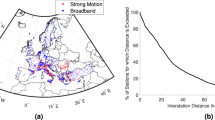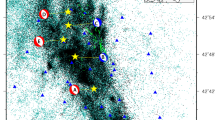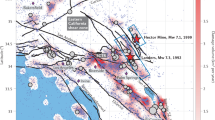Abstract
Recent advances in seismic sensor technology, data acquisition systems, digital communications, and computer hardware and software make it possible to build reliable real-time earthquake information systems. Such systems provide a means for modern urban regions to cope effectively with the aftermath of major earthquakes and, in some cases, they may even provide warning, seconds before the arrival of seismic waves. In the long term these systems also provide basic data for mitigation strategies such as improved building codes.
This is a preview of subscription content, access via your institution
Access options
Subscribe to this journal
Receive 51 print issues and online access
$199.00 per year
only $3.90 per issue
Buy this article
- Purchase on Springer Link
- Instant access to full article PDF
Prices may be subject to local taxes which are calculated during checkout


Similar content being viewed by others
References
National Research Council Real-time Earthquake Monitoring, EarlyWarningandRapidRespons 1–52 (National Academy Press, Washington, DC, (1991)).
Ellsworth, W. & Heaton, H. Real-time analysis of earthquakes: Early-warning systems and rapid damage assessment. Sensors (April) 27–33 (1994).
Noda, S. & Meguro, K. Anew horizon for sophisticated real-time earthquake engineering. J. Natural Disaster Sci. 17, 13–46 (1995).
Heaton, T. H. Amodel for a seismic computerized alert network. Science 228, 987–990 (1985).
Nakamura, Y. & Tucker, B. E. Japan's earthquake warning system: Should it be imported to California? California Geol. 41, 33–41 (1988).
Nakamura, Y. On the Urgent Earthquake Detection and Alarm System (UrEDAS).in Proc. 9th World Conf. Earthquake Eng. VII, 673–678 (Jpn Assoc. for Earthquake Disaster Prevention, Tokyo, Kyoto, (1988)).
Nakamura, Y. Real-time information systems for hazards mitigation.in Proc. 11th World Conf. Earthquake Eng.CD-ROM, Pap. No. 2134 (Pergamon, Oxford, (1996)).
Cret, A. & Katayama, T. On-line damage estimation for lifeline systems during earthquakes.in Proc. 10th World Conf. Earthquake Eng. 9, 5501–5504 (Balkema, Rotterdam, (1992).
Kikuchi, M. High-density strong-motion network in a large city (in Japanese). Kagaku 66, 841–844 (1996).
Espinosa-Aranda, J. M. et al. Mexico City Seismic Alert System. Seismol. Res. Lett. 66, 42–53 (1995).
Shin, T. C., Tsai, Y. B. & Wu, Y. M. Rapid response of large earthquakes in Taiwan using a real-time telemetered network of digital accelerographs.in Proc. 11th World Conf. Earthquake Eng.CD-ROM, Pap. No. 2137 (Pergamon, Acapulco, (1996)).
Lee, W. H. K., Shin, T. C. & Teng, T. L. Design and implementation of earthquake early warning systems in Taiwan.in Proc. 11th World Conf. Earthquake Eng.CD-ROM, Pap. No. 2133 (Pergamon, Acapulco, (1996)).
Teng, T.-l., Wu, L., Shin, T.-C., Tsai, Y.-B. & Lee, W. H. K. One minute after: Intensity map, epicenter, and magnitude. Bull. Seismol. Soc. Am. 87, 1209–1219 ((1997)).
Kanamori, H., Hauksson, E. & Ileaton, T. TERRAscope and CUBE project at Caltech. EOS 72, 564 (1991).
Gee, L. S. et al. Real-time seismology at UC Berkeley: The rapid earthquake data integration project. Bull. Seismol. Soc. Am. 86, 936–945 (1996).
Bakun, W. H., Fischer, F. G., Jensen, E. G. & VanSchaack, J. Early warning system for aftershocks. Bull. Seismol. Soc. Am. 84, 359–365 (1994).
Kanamori, H. Locating earthquakes with amplitude: application to real-time seismology. Bull. Seismol. Soc. Am. 83, 264–268 (1993).
Mori, J. et al. TriNet: State-of-the-art seismic and strong-motion network in southern California. EOS (submitted).
Goltz, J. D. Use of loss estimates by government agencies in the Northridge earthquake for response and recovery. Earthquake Spectra 12, 441–455 (1996).
Eguchi, R. T. et al. Real-time loss estimation as an emergency response decision support system. The Early Post-Earthquake Damage Assessment Tool (EPEDAT). Earthquake Spectra (in the press).
Yamazaki, F., Noda, S. & Meguro, K. Development of earthquake monitoring and early damage assessment systems in Japan. Bull. Earthquake Resistant Structure Research Center 30, 45–58 (Institute of Industrial Science, University of Tokyo, (1997)).
Turcotte, D. L. Fractals and Chaos in Geology and Geophysics 1–221 (Cambridge University Press, Cambridge, (1992)).
Brune, J. N. Implications of earthquake triggering and rupture propagation for earthquake prediction based on premonitory phenomena. J. Geophys. Res. 84, 2195–2198 (1979).
Author information
Authors and Affiliations
Rights and permissions
About this article
Cite this article
Kanamori, H., Hauksson, E. & Heaton, T. Real-time seismology and earthquake hazard mitigation. Nature 390, 461–464 (1997). https://doi.org/10.1038/37280
Issue Date:
DOI: https://doi.org/10.1038/37280
This article is cited by
-
Real-time determination of earthquake focal mechanism via deep learning
Nature Communications (2021)
-
Earthquake early warning: what does “seconds before a strong hit” mean?
Progress in Earth and Planetary Science (2018)
-
New magnitude scaling relations for earthquake early warning in the Alborz region, Iran
Acta Geophysica (2018)
-
Reviews of seismicity around Taiwan: Weibull distribution
Natural Hazards (2016)
-
Wavelet-Based Methods for Rapid Calculations of Magnitude and Epicentral Distance: An Application to Earthquake Early Warning System
Pure and Applied Geophysics (2015)
Comments
By submitting a comment you agree to abide by our Terms and Community Guidelines. If you find something abusive or that does not comply with our terms or guidelines please flag it as inappropriate.



